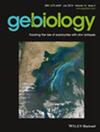A carbonate corrosion experiment at a marine methane seep: The role of aerobic methanotrophic bacteria
IF 3.4
2区 地球科学
Q2 BIOLOGY
引用次数: 1
Abstract
Methane seeps are typified by the formation of authigenic carbonates, many of which exhibit corrosion surfaces and secondary porosity believed to be caused by microbial carbonate dissolution. Aerobic methane oxidation and sulfur oxidation are two processes capable of inducing carbonate corrosion at methane seeps. Although the potential of aerobic methanotrophy to dissolve carbonate was confirmed in laboratory experiments, this process has not been studied in the environment to date. Here, we report on a carbonate corrosion experiment carried out in the REGAB Pockmark, Gabon‐Congo‐Angola passive margin, in which marble cubes were deployed for 2.5 years at two sites (CAB‐B and CAB‐C) with apparent active methane seepage and one site (CAB‐D) without methane seepage. Marble cubes exposed to active seepage (experiment CAB‐C) were found to be affected by a new type of microbioerosion. Based on 16S rRNA gene analysis, the biofilms adhering to the bioeroded marble mostly consisted of aerobic methanotrophic bacteria, predominantly belonging to the uncultured Hyd24‐01 clade. The presence of abundant 13C‐depleted lipid biomarkers including fatty acids (n‐C16:1ω8c, n‐C18:1ω8c, n‐C16:1ω5t), various 4‐mono‐ and 4,4‐dimethyl sterols, and diplopterol agrees with the dominance of aerobic methanotrophs in the CAB‐C biofilms. Among the lipids of aerobic methanotrophs, the uncommon 4α‐methylcholest‐8(14)‐en‐3β,25‐diol is interpreted to be a specific biomarker for the Hyd24‐01 clade. The combination of textural, genetic, and organic geochemical evidence suggests that aerobic methanotrophs are the main drivers of carbonate dissolution observed in the CAB‐C experiment at the REGAB pockmark.海洋甲烷渗漏处的碳酸盐腐蚀实验:好氧甲烷营养细菌的作用
甲烷渗漏的典型特征是形成自生碳酸盐,其中许多具有腐蚀表面和次生孔隙,被认为是由微生物碳酸盐溶解引起的。好氧甲烷氧化和硫氧化是引起甲烷渗漏处碳酸盐腐蚀的两个过程。虽然在实验室实验中证实了好氧甲烷化溶解碳酸盐的潜力,但迄今为止还没有在环境中研究过这一过程。在这里,我们报告了在加蓬-刚果-安哥拉被动边缘REGAB麻克马克进行的碳酸盐腐蚀实验,在两个有明显活跃甲烷渗漏的地点(CAB-B和CAB-C)和一个没有甲烷渗漏的地点(cabd)部署了大理石立方体2.5年。暴露于活动渗流(实验CAB-C)中的大理岩立方体受到一种新型微生物侵蚀的影响。基于16S rRNA基因分析,生物侵蚀大理岩上附着的生物膜主要由需氧甲烷营养菌组成,主要属于未培养的Hyd24-01支。丰富的13c -贫脂生物标志物的存在,包括脂肪酸(n-C16:1ω8c, n-C18:1ω8c, n-C16:1ω5t),各种4-单甲基和4,4-二甲基甾醇和双硫醇,与好氧甲烷氧化菌在CAB-C生物膜中的优势一致。在好氧甲烷氧化菌的脂质中,罕见的4α-甲基胆固醇-8(14)-en-3β,25-二醇被解释为Hyd24-01枝的特异性生物标志物。结构、成因和有机地球化学证据表明,好氧甲烷氧化菌是REGAB麻子ab - c实验中观察到的碳酸盐溶解的主要驱动因素。
本文章由计算机程序翻译,如有差异,请以英文原文为准。
求助全文
约1分钟内获得全文
求助全文
来源期刊

Geobiology
生物-地球科学综合
CiteScore
6.80
自引率
5.40%
发文量
56
审稿时长
3 months
期刊介绍:
The field of geobiology explores the relationship between life and the Earth''s physical and chemical environment. Geobiology, launched in 2003, aims to provide a natural home for geobiological research, allowing the cross-fertilization of critical ideas, and promoting cooperation and advancement in this emerging field. We also aim to provide you with a forum for the rapid publication of your results in an international journal of high standing. We are particularly interested in papers crossing disciplines and containing both geological and biological elements, emphasizing the co-evolutionary interactions between life and its physical environment over geological time.
Geobiology invites submission of high-quality articles in the following areas:
Origins and evolution of life
Co-evolution of the atmosphere, hydrosphere and biosphere
The sedimentary rock record and geobiology of critical intervals
Paleobiology and evolutionary ecology
Biogeochemistry and global elemental cycles
Microbe-mineral interactions
Biomarkers
Molecular ecology and phylogenetics.
 求助内容:
求助内容: 应助结果提醒方式:
应助结果提醒方式:


